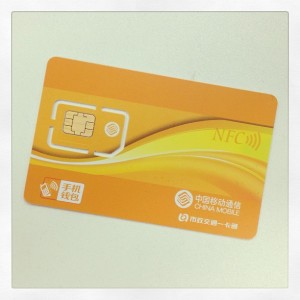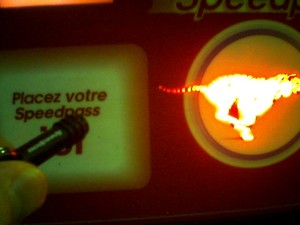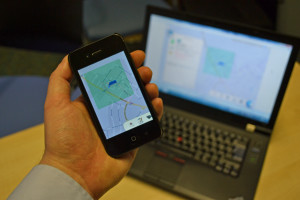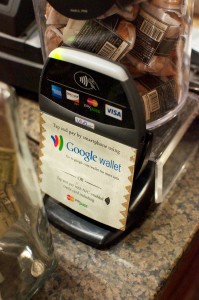November 22nd, 2013 by Admin
As we move to smartphones and tablets as payment methods security and privacy concerns are a real issue. With recent NSA leaks shedding light on our data and the access others have to it, we have to consider security, privacy and health implications. This year alone e-commerce transactions on smartphones and tablets during the holiday season are set to grow by 15%. Although tablets, not smartphones will drive the bulk of that growth, smartphones are set to overtake mobile-commerce payments over the next 5 years. Tablet payments in the U.S. alone are expecting to reach $26 billion in transactions. Currently tablets are more convenient for m-commerce due to their size, but as far as the future of electronic payment processing, smartphones are where it’s at.
The smart merchant sees this coming and realizes frictionless transactions increase sales. The more comfortable and less complicated a transaction is for a customer, the better. Smartphones, tablets, PCs, laptops and more can already process electronic transactions from credit and debit cards, gift cards, electronic checks and more. Money movement is easier than ever and more convenient than cash. Cash is king however in situations where internet connectivity and power are an issue. In India for example, a poor electric grid makes power outages a common occurrence. During natural disasters, when resources are badly needed, power outages or severed internet communications mean no electronic transactions can be processed. So physical currency remains a must, in the future we may see payment technology evolve to where digital money like crypto currency (BitCoin) may be stored on the device itself similar to having cash. As these electronic payment systems evolve, merchants need to position themselves to accept what their market prefers to transact with.
The smart citizen also sees this coming and has concerns that things like a National ID program being established may compromise their privacy.
As an extreme example of electronic transactions, a nightclub in Spain used subdermally implanted RFID chips in a woman that allowed patrons to pay for food and beverages without a credit card.
Posted in e-commerce & m-commerce, Electronic Check Services, Electronic Payments, Gift & Loyalty Card Processing, Merchant Services Account, Near Field Communication, Smartphone Tagged with: bitcoin, cash, connectivity, credit, crypto currency, currency, debit cards, digital money, e-commerce, electronic, electronic checks, frictionless, Gift Cards, health, internet, laptops, leaks, m-commerce, Merchant's, mobile-commerce payments, money, national id, nsa, pay, payment methods, payment processing, PCs, privacy, processed, RFID, Security, smartphone, tablets, technology, transact, transactions
October 29th, 2013 by Elma Jane
In addition to my article about Credit Card Purchases give way to Tap and Go.
I would like to add an example of contactless payments which was introduced in 1997 called Speedpass.
Speedpass is a keychain RFID (Radio Frequency Identification Device) introduced in 1997 by Mobil Oil Corp. (which merged with Exxon to become ExxonMobil in 1999) for electronic payment. It was originally developed byVerifone. As of 2004, more than seven million people possess Speedpass tags, which can be used at approximately 10,000 Exxon, Mobil and Esso gas stations worldwide. Speedpass has also been previously available through a Speedpass Car Tag and Speedpass-enabled Timex watch.
Speedpass is another example of “contactless” payment system that provides members with a quick and easy way to pay for purchases at participating Exxon and Mobil stations nation-wide. Speedpass is similar to the electronic toll technology successfully used on subway, bus, and highway systems around the world.
Speedpass key tag has a built-in chip and radio frequency antenna that allows it to communicate with Speedpass readers at gasoline pumps, convenience store terminals, and car wash kiosks at Exxon and Mobil locations.
A quick wave of your Speedpass key tag in front of the reader initiates the automatic transmission of a unique identification and security code to the Speedpass payment system so your account can be located. Your payment is instantly processed using the credit/debit card that is linked to your Speedpass. If the transaction is approved, you will receive a payment confirmation and you can be quickly on your way.
You can securely access your Speedpass account and change the credit/debit card that is linked to your device. You can also specify whether or not you would like to receive a receipt for gasoline purchases made at the pump using your Speedpass. Even if you change your receipt settings to specify that you don’t want a printed receipt, you can always view your complete Speedpass transaction history and all electronic receipts online by logging into your account at any time.
Speedpass is safe and secure. Your card information, preferences, and personal details are not stored in your Speedpass device, so your information is protected from unauthorized use.
Speedpass is a cool payment method for people on the go! You can use your Speedpass to pay for gasoline, food, merchandise, and car washes at participating Exxon and Mobil locations nation-wide.
Speedpass Benefits:
Fast and Convenient
Simply wave your Speedpass key tag across the area of the gasoline pump, convenience store terminal, or car wash kiosk that says “Place Speedpass Here”.
Free
There are no fees to acquire or use Speedpass key tags.
Easy and Simple
When you use Speedpass, there is no need to sign a receipt.
Online Account Access
If you are an existing Speedpass member, you can login to speedpass.com to access your account 24/7. You can review your purchase history, access electronic receipts, update your contact information, change the credit/debit card that is linked to your device, and more! If you are an existing member, but don’t yet have a username and password, setup your online profile today by clicking on the My Account button on this site.
Safe and Secure
Your credit/debit card number and personal information are not stored in
your Speedpass device.
Posted in Electronic Payments, Mobile Point of Sale, Near Field Communication Tagged with: antenna, built-in-chip, communicate, confirmation, contactless, convenience store, credit card purchases, electronic, electronic toll, exxon, fees, keychain, kiosks, locations, logging into, merchandise, mobil oil corp, nation-wide, online, payments, radio frequency identification device, receipts, RFID, security code, speedpass, Tags, tap and go, terminals, timex, transaction, unauthorized, verifone, watch, wave
September 17th, 2013 by Admin
Payments
“Geofencing” a program that uses the global positioning system (GPS) or radio frequency identification (RFID) to define geographical bounderies. It creates the opportunities for new business models and generations. Allowing the use of mobile tools and services to not only interact with loyal customers, but also reach potentially new customers when they come into a geographic proximity, explained by a spokesperson from a Mobile and Wireless Group. So it does open the doors to some interesting new applications.
To date, radio positioning signals have been supplied to consumers primarily by the U.S. Military through a constellation called “GPS” or Global Positioning System. Essentially, receivers on the ground…. or in cars….interpret the signals and tell you roughly where you are.
Europe’s Galileo global satellite navigation system is expected to open up a variety of business opportunities. Big changes are in the air as a result of new more accurate systems on the way. One example: geofencing, a highly targeted form of tight, perimeter-based locating.
Galileo
A form of geofencing using the U.S. GPS is already used to monitor stolen vehicles, trucks and delivery drivers, among other things. GPS isn’t particularly accurate, though. With more accuracy, geofencing could be used to create a zone around a store or school, for example…or even a particular vending machine, in the world of commercial applications.
One of the new systems offering fresh potential in this area is Europe’s upcoming Global Satellite Navigation System, or GNSS, Known as Galileo.
“Global Applications”
Where Galileo gets particular interesting for us in the e-commerce world is that, buried deep in the European Space Agency’s promotional descriptions are some telling statements. For example, Galileo will offer a commercial service that will “allow global high-end and innovative applications” with accuracy down to a few centimeters.
For comparison , GPS maker Garmin says its latest GPS receivers are accurate to within 3 to 5 meters. Second, despite being a government project, Galileo will be under civilian control…not government control the way GPS is. It will be fully open to commercial applications. Then too, there’s aunthentication feature Galileo will include…an accurately timed, trusted location factor. The Galileo Commercial Service demonstrator will begin its proof of concept in 2014, with early service reckoned to start in 2016.
Possible Sensitive Transactions
Why do we care about all this? Simple: because of Geofencing.
Geofencing is currently used in mobile e-commerce to deliver ads and promotions based on a geographical region of interest. The GPS is used to define proximity so that an advertiser can know when you’re in the area.
Now add Galileo’s authentication to this mix, plus the microlocations obtainable with Galileo, and you’re in a defferent ballpark…almost literally. Sensitive transactions become possible, along with tracking to the millimeter… when you enter a building, go to the zoo or choose a concert seat. Turnstiles and the cost involved become redundant, for example.
Current location-based access control and payments solutions that use a GPS signal are authenticated through proprietary algorithms.
Security Improved
By virtue of its ability to enable transaction security and access control improvements, in fact, Galileo’s authentication feature will ultimately be perceived by industries such as banking to be a source of added value.
“For example, GNSS-based positioning and accurate timing could be integrated in the encryption algorithms to improve the security and payment process.
Location-based billing using existing GPS is already in use in limited areas including toll-road billing, and it’s being considered for parking as well. However, one of the big problems has been the availability of equipment that’s small enough and power-friendly enough to be practical.
The Technology on the ground…the device in our pocket, in other words…is a limiting factor. If you’ve ever tried to use your smartphone’s GPS chip for more than a few hours, you’ll know it kills the battery, even the the latest phones. Current vehicle geofencing trackers, meanwhile, are large, permanently mounted boxes. New chips will provide portability.
“This Previously Wasn’t Possible”
A mobile and wireless company, recently inroduced a battery-saving GNSS smartphone location chip with Geofence capabilities. The company’s BCM47521 chip lets an application receive an alert when a user enters or exits a virtual perimeter, and uses the current GPS, GLONASS, QZSS and SBAS constellations…all at the same time.
What is unique about this technology is that it’s able to monitor the user’s location as a background task, consuming less power. “This previously wasn’t possible, as the process of continually monitoring for a geofence would rapidly drain a mobile device’s battery”.
Near Field Communications radio standards can be used for the secure payment element, and the more widespread adoption of NFC for mobile payments will also generally help drive adoption of location-based payments.
“Geofencing creates the opportunities for new business models, allowing the use of mobile tools and services to not onl interact with loyal customers but also reach potentially new customers hen they come into a geogrphic proximity.” “So it does open the doors to some interesting new applications.”
“Security and Privacy Crucial”
A networking and connectivity subsidiary is also working on positioning. It’s IZ at location platform is geared towards precise indoor positioning for public places and provides 3- to 5-meter positioning inside.
GNSS will help enable location-based payments, but it’s not everything. “There will certainly be other augmentation technologies that will help to increase the propagation of this in the market. “Security and privacy will also be crucial to acceptance.”
Indeed today, the tested indoor services need to rely on antennas installed outside the target buildings to reproduce the GNSS signal. This requirement causes additional costs, challenging the economic viability of GNSS-based positioning as a means to reinforce the security of access and transactions. Add in the vast amounts of data gained by tracking user movements down to the centimeter, and you’ve got a whole other can of worms.
Posted in Credit Card Security, Electronic Payments, Mobile Payments Tagged with: Geofencing, GPS, payments, privacy, RFID, Satellite, Security, technology, transactions
Cashless electronic payments are the latest rage. Estimates for smartphone payments using NFC chips is expected to explode, though many estimates are being adjusted. The technology seems to be expected but digital wallet offerings are lacking for sure. AT&T customers still cannot use the default Google Wallet app, and ISIS is in a forever Beta mode. Starbucks seems to have embraced NFC based electronic transactions as well as digital wallet providers Lemon, LevelUp and others. Sprint adopted Google Wallet early on, while Verizon, AT&T and T-Mobile users have been waiting for ISIS to come out of beta in Texas and Utah test beds. The other half of the problem, adoption, is slow as merchants need to invest in new credit card terminals and readers that incorporate the NFC technology to be able to accept these digital payments. Read more of this article »
Posted in Electronic Payments Tagged with: AT&T, Cashless electronic payments, Debit Card transactions, Gift Cards, Google Wallet app, GPS, Lemon, LevelUp, Loyalty Programs, MicroChip Payments, nfc, NFC chips, Offerings, RFID, smartphone, T-Mobile



